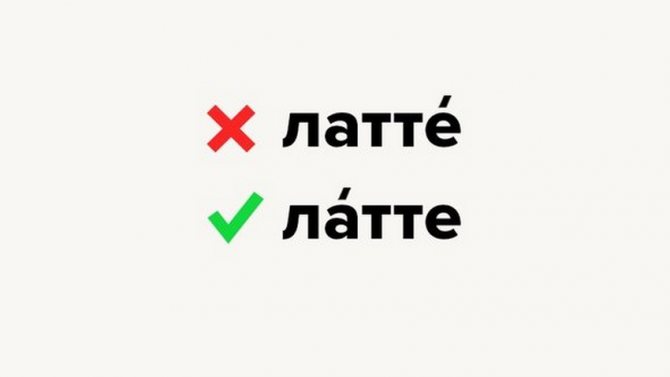Which syllable is stressed in the word latte?
Not long ago we heard the opinion that the emphasis in the word “latte” should be placed on the last syllable. Let's figure out where the word came from and which vowel will be stressed?
“Latte” is a word borrowed from Italian and translated as “milk.” The name of the drink “coffee latte” literally means “coffee with milk”.
A little history
Today it is impossible to name the discoverer of the recipe. The authorship is disputed by the French, Italians and Austrians. If we turn to historical sources, there are recorded references to making coffee with milk in the stories of travelers about the Austro-Hungarian Empire, as well as in essays about Venice, Holland and other European countries.
Italians have their own version of the origin of the drink.
Once upon a time there was a certain bartender or even a barista, and he served visitors to his establishment, among other drinks, the most common milk - “latte” in Italian. But one day he wanted to improve the taste of a familiar product, and he added a little coffee to the milk. Not only he, but also the guests of the establishment liked the drink. They didn’t come up with a name for it, they left everything as it is – latte coffee. In Russian translation - coffee with milk.
No matter who came up with the recipe, it was the Italian name that stuck in European barista practice. There is nothing surprising about this - many terms in the modern coffee business are of Italian origin. And since the word is Italian, they pronounce it in the Italian manner, with emphasis on the first syllable.
Of course, most European languages have their own equivalent recipe names.
- In French: cafe au lait. The French version is pronounced without a final consonant and sounds like one long syllable “le”.
- In Spanish they say: café con leche. The phonetics of the Spanish word resembles the Italian version and sounds with the same stress on the first syllable.
Here we could recall the common Indo-European linguistic roots, but it seems that we have gone too far in our small study.
Let's return to the modern latte. We found out that the word is Italian and is pronounced with emphasis on the first syllable. But let's see how foreign language borrowing behaves in our native Russian language. Perhaps the emphasis changes in the Russian version?
Why is the emphasis on the first syllable?
In Italian, in most words the stress is on the first syllable unless special parameters apply. We will not go into the features of another language. In the Russian language, the stress in borrowed words is preserved similar to the original source, that is, as it is placed in another language, it is placed in Russian.
That is why in the word “latte” the stress is placed on the first syllable. To remember, just remember about borrowing this word from another language and remember the translation of “latte” - “milk”.
What is the correct stress in the word “latte” for the Russian language?
In Russian coffee shops and in everyday life, we hear the name of the Italian recipe in different pronunciations. Sometimes this leads to heated arguments. Let's approach the issue from the perspective of language rules.
The word is new to the Russian language, having come into use quite recently.
By the way, “coffee” is also considered a relative newcomer to the Russian language, although we have been using this name for about 300 years, and it has long been part of the active vocabulary.
New borrowed words in Russian are used according to the scheme of the source language. This happens until the influence of our native speech changes the borrowing according to the rules adopted in the Russian language. But this does not happen immediately and not soon. Therefore, the term “latte” is used according to the rules of the Italian language, with the emphasis on the first syllable.
Foggy future
If this word lives in our linguistic space long enough, it will change its pronunciation. It can be assumed that in the future the double consonant will disappear, and the hard pronunciation of “t” will change to soft, as often happens in our language. It is quite possible that the stress will move to the last syllable, but these processes will take more than a dozen years. Until then, the phonetics of the source language is preserved, along with stress and pronunciation features.
How to put stress in the word latte
Don't know how to spell latte or latte? Now I’ll tell you (see what type of word coffee is).
There is always a lot of controversy surrounding this issue. Let's spare the ears of experienced baristas (see barista courses in Moscow) and learn how to correctly pronounce the name of your favorite drink.
The emphasis should be on the first syllable. Emphasize the letter “A” when saying the name or placing an order.
Let's turn to the authorities
Until recently, the word “latte” did not have a dictionary fixation in the Russian language. That is, it was not included in any dictionary. This is a typical phenomenon for neologisms or recent borrowings.
But a few years ago the name of the drink received official status. The word “latte” was included in the 2012 edition of the “Russian Spelling Dictionary”. This is an authoritative academic publication edited by the famous Russian philologist V.V. Lopatina. The dictionary was published by the Russian Language Institute of the Russian Academy of Sciences and deserves every confidence.
In this edition, the word “latte” is designated as a lexeme with stress on the first syllable. As for the remaining grammatical features, the word has a masculine gender and an unchangeable form, that is, it does not decline cases and has no numerical forms.
According to the rules, you can't say
- "my latte"
- “The lattes are hot.”
Only in the masculine gender:
- "my latte"
- "The latte is hot."
For those who just can’t remember what emphasis should be placed in the name “latte,” we offer a humorous mnemonic formula for better memorization: “Take your paws off the latte!” or “Coffee Latte does not wear armor”
The history of latte
Latte, oddly enough, was invented by Italian housewives. Once upon a time, the entire Italian family sat down at the table and started having breakfast. Adults drank natural black coffee, and to make children feel equal to adults, hot milk was poured into their drink, thereby reducing the caffeine concentration. Children's coffee was a little tainted, so it was called "stained milk", which sounds like "latte" in Italian.
Since those ancient times, the preparation of the drink has acquired many traditions and conventions. Many even believe that making a latte at home is impossible, because whipping strong foam requires special equipment. But for a true latte lover, this is not a problem, because milk foam can be made using a blender. Of course, it will not be too dense and stable, but this will not affect the taste of the drink.
Such coffee with milk during pregnancy will benefit the woman and her child.
What do you need to know about the accent in the word "latte"?
- This is a borrowed language unit of Italian origin.
- In the source language it is pronounced with emphasis on the first syllable.
- In the Russian language it has a dictionary fixation in the “Russian Spelling Dictionary”.
- In Russian, it is used according to the rules of the source language: with emphasis on the first syllable, firm pronunciation of the consonant sounds “t” and a weakened sound “e” at the end of the word.
What uses of the term “latte” have you heard?
Emphasis on the word "latte"
In this word, the stress is always placed only on the first syllable , that is, “latte” . The word does not change according to cases and is not declined.

Speak:
- give me a couple of lattes;
- This coffee shop has good lattes.
Illiterate and a violation of language norms . In all variations, you should simply use the word “latte.”
How to pronounce correctly
Perhaps the problem with pronunciation is due to the fact that many people consider this title to be French. After all, most of the gastronomic borrowings came to the Russian language from France. And in French, as is clear, the last syllable is almost always stressed. In order not to be mistaken in the same way, all coffee connoisseurs need to know about the origin of the name of this tart drink.

People who pronounce the name of a popular coffee in the French manner are wondering whether it is possible to say latte with an accent on the end. Moreover, this variant of pronunciation is more common in our country.
At the modern stage of language development, the question of where to put the stress in the word latte has one answer: on the 1st syllable, only this option is commonly used and desirable.
But Russian stress is flexible and in the near future there is a tendency for it to shift from the beginning of the word to the end. In addition, the emphasis on the last syllable makes the pronunciation of the word more natural for the Russian language. Taking these reasons into account, one can imagine that after some time, stress on the end of a word will become the norm.
Origin of the name of the recipe
The correct pronunciation in this case depends on how the emphasis is placed in the homeland of this drink, in Italy. It was there that the unique combination of coffee and milk was born, which has become a favorite drink for many people around the world. Our fellow citizens are accustomed to the fact that the names of recipes coming from other countries sound very special. That is why many people place the emphasis in the word “latte” specifically on the last syllable. This variant is essentially more similar to French than to Italian, where this word comes from. This color scheme is more familiar to Russian inhabitants, who are accustomed to the fact that most of the culinary delights came specifically from France.

In Italy, the phrase “coffee with milk” is denoted by one word “latte”, and the emphasis in it is only on the first syllable. This is the only correct way to pronounce this beautiful word. In addition to coffee latte, there are several other names associated with the fragrant drink, which not everyone says and spells correctly.
Delicious coffee latte recipe
To make the usual version of the drink, you need to take the following ingredients:
- roasted and ground coffee beans;
- filtered cold water;
- whole milk;
- sweet sand.
The freshest coffee is poured into the heated frothed milk so that it is under the milk foam.
It is very important to pronounce the names of your favorite drinks correctly; this is a sign of education and a nuance of good tone.
The origin of the word Latte, how to pronounce it correctly and put the emphasis.
Many people love latte coffee, but not everyone knows that this foreign word is correctly pronounced with the emphasis on the first syllable. This pronunciation of the name is explained by its appearance in the Russian language.
The word came to us from Italian. In Italy, where this delicacy was invented, the name of the drink consists of two nouns, caffe latte, and means “coffee with milk.” That is why this dessert is known for the mild taste of natural milk, pleasant aroma and unusual color. We borrowed only the second part of the Italian name. Italians place the emphasis in the word latte on the first syllable, so it is correct for us to pronounce this name the same way.
You already understand how to put the accent correctly, now let’s figure out whether everything is absolutely correct with the pronunciation of this type of coffee, and at the same time find out the gender and spelling of the world’s favorite drink.
Which is correct: latte or latte
Competent coffee drinkers pronounce this word without mistakes.
In the “Russian Spelling Dictionary” of the Russian Academy of Sciences, the Latte vocabulary norm is recorded with the emphasis on the first syllable: latte. This pronunciation is traditionally considered correct, since it duplicates the norm of the source language. The fact is that the noun latte comes from Italy, and in the Italian language the last syllable is rarely stressed.
Probably, the tendency to pronounce latte is associated with the erroneous assumption that this name, by analogy with glace, came from France (as you know, the French usually put the emphasis on the last syllable). The reason may also be that it is simply more convenient for a Russian person to say latte. The stress in the Russian language is variable and unstable - so to speak, it loves freedom. There is also a tendency to move from one syllable to another, closer to the end of the word.
By the way, the full Italian name for this exquisite drink is caffè latte, that is, coffee with milk. If you order just a latte in Italy, they will bring you a glass of milk. We use the truncated version and never say: “Please bring me a latte.”
It is curious that the noun latte can Gramota.ru. Question No. 278345 can be used in both the masculine and neuter gender. You also need to remember that types of coffee drinks are written in Gramota.ru. Question No. 240788 without quotes and without a hyphen: latte coffee, cappuccino coffee, espresso coffee.
Source of the article: https://lifehacker.ru/latte-udarenie/











